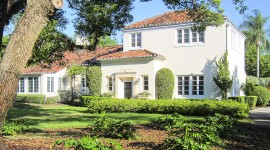Country Club Suburb
A planned residential district containing one or more subdivisions offering middle and upper middle-class homes in park-like settings with up-to-date public utilities, tree-lined streets, community amenities (such as golf courses), and access to several modes of transportation. Associated with the advent of local planning and zoning in American cities, developers used protective covenants (a.k.a. deed restrictions) to set forth architectural standards and minimum setbacks, control the cost of dwellings, prohibit non-conforming land use, and ensure the homogeneity of residents by excluding certain groups on the basis of race, income, and / or religion. These restrictions became unenforceable with the 1948 Supreme Court decision Shelley v. Kraemer.
Common characteristics include curvilinear streets, architect-designed houses, spacious yards, paved and tree-shaded streets, sidewalks, driveways and garages, community parks and playgrounds, and country clubs. Designed for automobile use, these communities were often connected with the city by way of boulevards and parkways.












